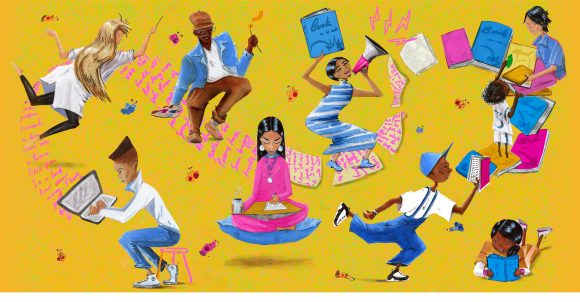 Since its release, the Diversity Baseline Survey (DBS) has become the most visited blog post we have ever produced. The DBS has been widely read and written about, and has opened up a renewed interest in how to improve staff diversity in the publishing industry. In our first piece, Behind the Scenes of Publishing’s First Diversity Baseline Survey, we covered the methodology and obstacles we faced conducting the survey. In this piece we will shed light on what happens next—and what’s already happening to improve the numbers.
Since its release, the Diversity Baseline Survey (DBS) has become the most visited blog post we have ever produced. The DBS has been widely read and written about, and has opened up a renewed interest in how to improve staff diversity in the publishing industry. In our first piece, Behind the Scenes of Publishing’s First Diversity Baseline Survey, we covered the methodology and obstacles we faced conducting the survey. In this piece we will shed light on what happens next—and what’s already happening to improve the numbers.
We surveyed a handful of the publishers and reviewer journals that participated in the DBS and asked them what initiatives they are planning or already have in place to make diversity a priority in their organizations. Here are some of the responses we received back:
Kiera Parrott, Reviews Director, School Library Journal and Library Journal: Participating in the survey was the first concrete and actionable thing I could do to be part of the solution. Even though I had a fair guess on the demographic makeup of our reviewers (most of them were recruited from ALSC committees, and that group is rather homogenous), I wanted actual numbers. My hope was that the statistics would help me pinpoint exactly where we needed to grow and develop.
The next steps after the survey have been 1) intentionally recruiting more diverse reviewers, and 2) developing diversity/cultural literacy training for our existing reviewers. Sometime in mid-2016, I’m launching a special course just for SLJ reviewers on diversity and cultural literacy. We anticipate this course beginning sometime in late Spring/early Summer.
Editorial note: Kiera also gives a much more detailed report on her progress diversifying her reviewer pool in an interview she gave at the Reading While White blog.
Jason Low, Publisher, Lee & Low Books: While many are aware of our 25-year mission to publish award-winning diverse books, we currently have several other initiatives in place.
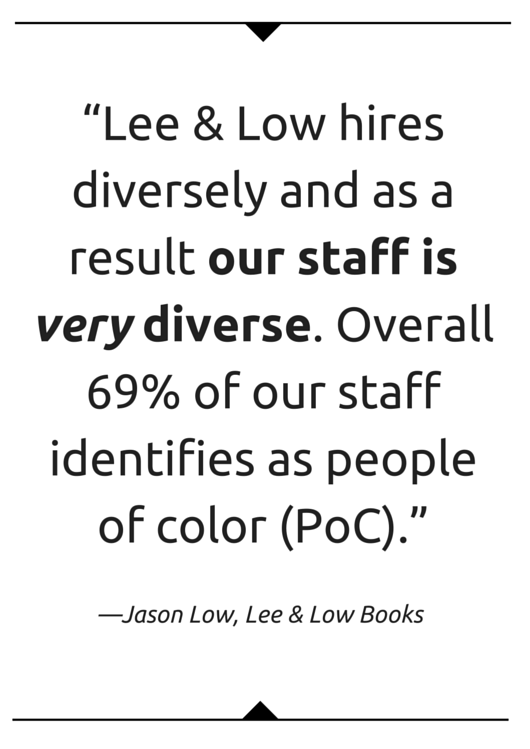 To start, since the DBS was all about staff diversity, Lee & Low can firmly state that we practice what we preach. Lee & Low hires diversely and as a result our staff is very diverse. Overall 69% of our staff identifies as people of color (PoC). Departmentally the company breaks down like this: editorial: 50% PoC; marketing/publicity: 75% PoC; sales: 50% PoC; Operations: 100% PoC. We have fluent Spanish speakers in editorial, marketing/publicity, and sales.
To start, since the DBS was all about staff diversity, Lee & Low can firmly state that we practice what we preach. Lee & Low hires diversely and as a result our staff is very diverse. Overall 69% of our staff identifies as people of color (PoC). Departmentally the company breaks down like this: editorial: 50% PoC; marketing/publicity: 75% PoC; sales: 50% PoC; Operations: 100% PoC. We have fluent Spanish speakers in editorial, marketing/publicity, and sales.
Staff Diversity Training: Last year we sent a number of LEE & LOW staff members from different departments to an “Undoing Racism” workshop, held by the People’s Institute for Survival and Beyond. We decided to do this workshop because even with LEE & LOW’s focus on diverse books, we felt that our staff would benefit from specific training in anti-racism concepts.
Author Award Contests: We sponsor two author awards for unpublished writers of color. Our New Voices Award is in its 17th year. The New Voices Award has launched the careers of 14 authors of color (with the work of three more authors currently in development), and we have given honor awards to another 11 authors. In 2013, we launched the New Visions Award, an award for unpublished authors of color who write middle grade and young adult novels.
Diversity in Publishing Internship: To address the lack of opportunities for diverse staff in publishing, we converted our paid internship program to one that is for diverse candidates only. Our internship program is designed to give candidates the kind of publishing experience and exposure they would need to consider a career in publishing.
Lee & Low and Friends Scholarship: In partnership with the Center for the Study of Children’s Literature at Simmons College, we have established a scholarship to increase diversity at the graduate school level. The Lee & Low and Friends Scholarship provides opportunities for students of color to enroll in the most prestigious children’s literature graduate program in the United States.
Diversity Gap Series: We published a series of eight studies that include statistics and interviews illustrating that the lack of diverse representation is a society-wide problem. The subjects covered so far: The Tony Awards, The Emmy Awards, The Academy Awards, The children’s book industry, The New York Times Top 10 Bestseller List, US politics, Sci-Fi and Fantasy Films, and Silicon Valley.
Angus Killick, Vice President/Associate Publisher, Macmillan Children’s Publishing Group and Monique Patterson, Editorial Director, Romance and Executive Editor, St. Martin’s Press: Macmillan established a Diversity & Inclusion Council this 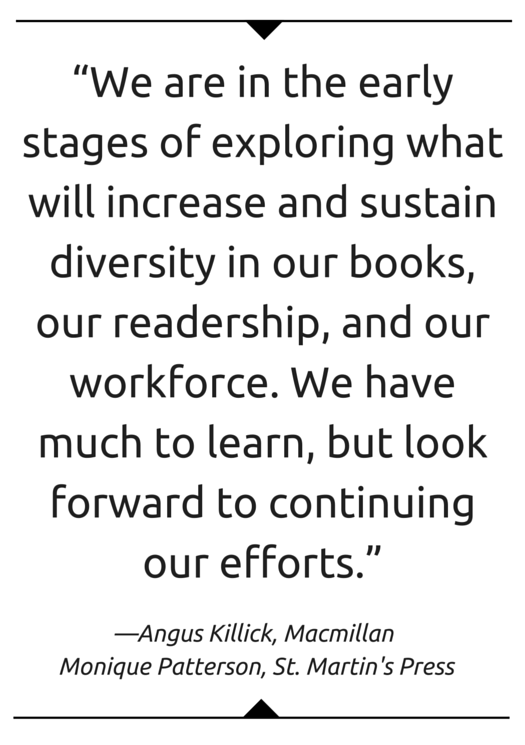 year aimed at promoting a broader representation of differences—gender, race, ethnicity, religion, sexual orientation, physical ability, age, gender identity and expression, family status, economic background and status, geographical background, and perspective in the workforce and the books we produce. The Council steers Macmillan’s diversity and inclusion efforts, and 1) determines priorities for programs and activities aimed at enhancing diversity in our books and authors and in our recruitment and retention efforts; 2) oversees sub-committees established to focus on individual priorities; 3) measures the results of our initiatives; and 4) reports back to the larger organization.
year aimed at promoting a broader representation of differences—gender, race, ethnicity, religion, sexual orientation, physical ability, age, gender identity and expression, family status, economic background and status, geographical background, and perspective in the workforce and the books we produce. The Council steers Macmillan’s diversity and inclusion efforts, and 1) determines priorities for programs and activities aimed at enhancing diversity in our books and authors and in our recruitment and retention efforts; 2) oversees sub-committees established to focus on individual priorities; 3) measures the results of our initiatives; and 4) reports back to the larger organization.
We’ve formed a number of sub-committees and each is involved in projects. For example, the Outreach Committee is creating a Publishing Ambassador Kit, so any employee can visit a middle or high school and talk about careers in publishing—not just in editorial, but in marketing, production, finance, IT. The Recruiting and Retention committee worked with We Need Diverse Books to expand our Intern pool this past summer and has expanded recruiting efforts to schools outside the tri-state area. The Acquisition and Marketing Committee is developing strategies for editors and imprints to broaden submissions both from the one-on-one meetings of editors and agents and from outreach to organizations such as the Asian American Writers Workshop or historically black colleges and their writing programs. Also, our Council is looking into participating in events such as the Harlem Book Fair and the LGBTQ Graphic Novels event. We have also reached out to the AAP and Young to Publishing to find ways to expand on what already exists. Macmillan joined other publishers in September in a baseline survey on our workforce and added several questions of its own to measure awareness and attitudes about Diversity and Inclusion.
We are in the early stages of exploring what will increase and sustain diversity in our books, our readership, and our workforce. We have much to learn, but look forward to continuing our efforts.
Vicky Smith, Children’s & Teen Editor, Kirkus Reviews: I’m not sure you can call an intention an initiative, but we are working hard to describe race and ethnicity accurately when we see it in the books that we review, as well as sexual orientation, gender identity, and disability. We hope that by including that information in our reviews 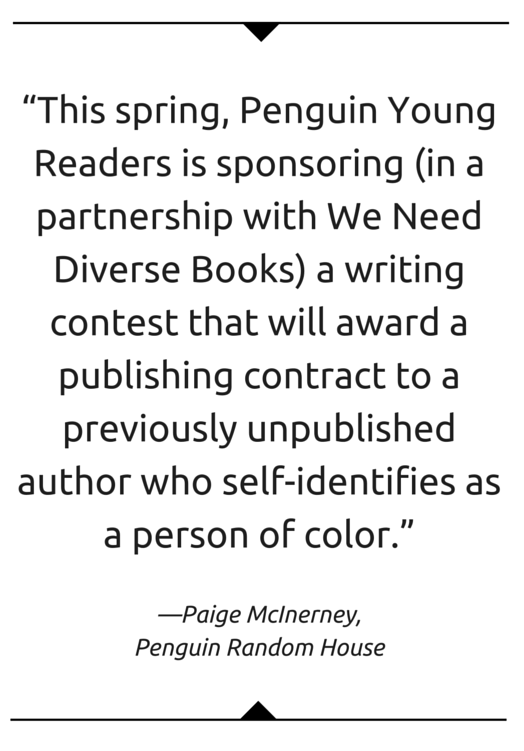 our readers will be able to make the most responsible purchasing decisions for their homes and libraries. I am also actively recruiting reviewers of diversity (for lack of a better term), who will provide a variety of lenses into the literature.
our readers will be able to make the most responsible purchasing decisions for their homes and libraries. I am also actively recruiting reviewers of diversity (for lack of a better term), who will provide a variety of lenses into the literature.
Paige Mcinerney, Vice President Human Resources, Penguin Random House: Our commitment to fostering diversity is reflected in our day-to-day workplace conduct, as well as by how we continue to find, develop, and publish a wide range of authors from many different cultural backgrounds, across all genres, for diverse audiences of readers everywhere.
At Penguin Random House, we have a robust, paid Internship Program. In recruitment for this program, we actively work with several diversity partners with whom we have longstanding and productive relationships. These include, among others, The Posse Foundation, Prep for Prep, and beginning in 2016, the United Negro College Fund in partnership with the Association of American Publishers. We work with these groups on all internship recruitment and also commit to filling a percentage of our internship openings with qualified candidates from these organizations.
Some of our divisions have employee groups that meet regularly to discuss how to maximize the potential of our diversity-related books, and how to make sure that their division is working toward as much inclusiveness as possible.
This spring, Penguin Young Readers is sponsoring (in a partnership with We Need Diverse Books) a writing contest that will award a publishing contract to a previously unpublished author who self-identifies as a person of color or non-Caucasian.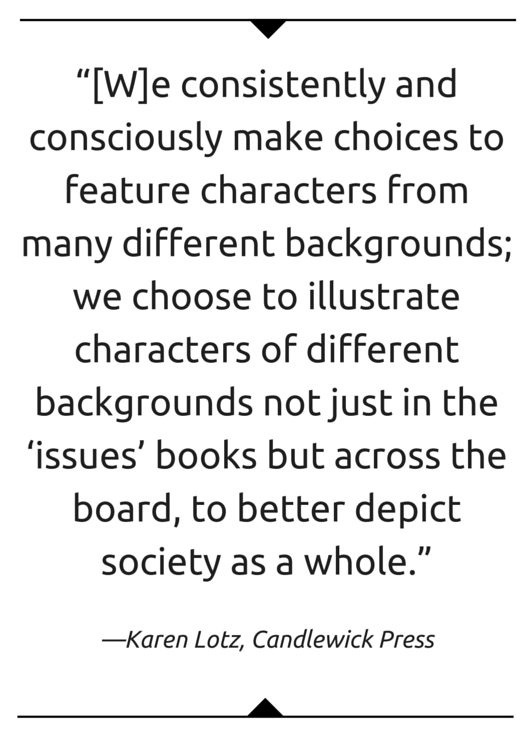
Karen Lotz, President and Publisher, Candlewick Press: As an independent publisher, we’ve always understood that it’s our authors and illustrators who set us apart. Our roster of creators includes new and established talents from all backgrounds who themselves are committed to ensuring that ALL readers will be able to see themselves and the people they love reflected in the pages of—and on the covers of—the books they read. On the corporate level, from the covers of the Candlewick advertising catalog to our featured titles at conventions and shows, we consistently and consciously make choices to feature characters from many different backgrounds; we choose to illustrate characters of different backgrounds not just in the ‘issues’ books but across the board, to better depict society as a whole. We hope this creates an open and inviting atmosphere where authors and artists from diverse populations will feel welcome to publish. We understand, furthermore, that the economic support and financial offers we make to artists and authors and the quality we invest in producing each and every title are important to attract all authors and artists, certainly including those from diverse backgrounds.
And finally, we are very proud of the recognition our books have come to receive from outside groups, including recent NAACP Image and Honor Awards; Stonewall Awards and Honors; Pura Belpré Awards and Honors; and Coretta Scott King Awards and Honors. We are particularly grateful this year to the Coretta Scott King Committee for their bestowal of the John Steptoe New Talent Award to Ekua Holmes for Voice of Freedom: Fannie Lou Hamer, because at Candlewick we really work very hard to try to discover new talent and give brand-new creators of children’s books a graceful and rewarding entry into the world of children’s publishing.
This same commitment to creating a welcoming environment extends to our staffing. In recruiting, we make every effort to reach out to educational institutions and organizations whose goal is to cater to diverse populations. We have a special art resource coordinator on staff whose role is exclusively dedicated to seeking new talent from art schools and programs; she communicates wherever she goes that Candlewick welcomes artists from diverse backgrounds and with diverse interests. Throughout their careers, we support and encourage all of our staff to continue their participation in diversity studies, panels, and educational programs, including the CBC’s diversity program efforts and other local and national opportunities, including WNDB initiatives. We support our authors when they wish to do the same. We also work very closely with First Book and Jumpstart, as well as other literacy 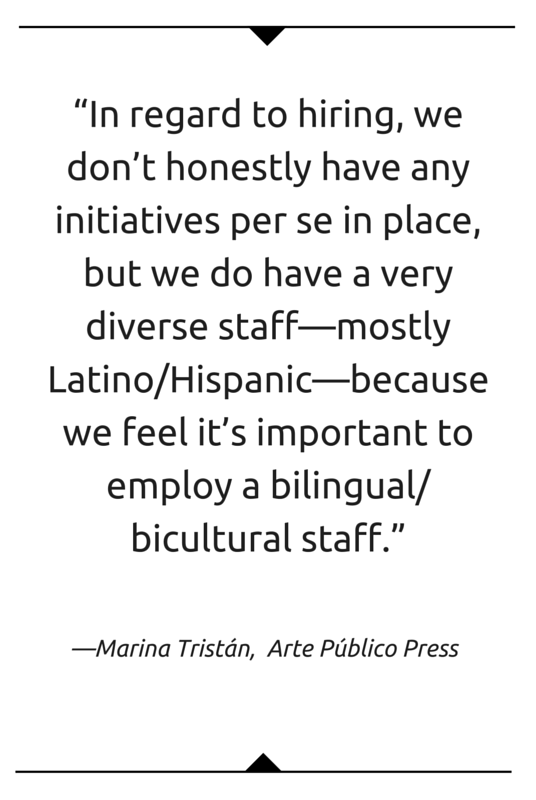 organizations whose goals include getting high-quality and appropriately representational books into the hands of all children—regardless of their families’ compositions, backgrounds, or economic situations.
organizations whose goals include getting high-quality and appropriately representational books into the hands of all children—regardless of their families’ compositions, backgrounds, or economic situations.
Marina Tristán, Assistant Director, Arte Público Press: We obviously work to promote Latino books and authors, but we also try to promote books by other minority writers and publishers via our social media pages and in conversations with teachers and librarians.
In regard to hiring, we don’t honestly have any initiatives per se in place, but we do have a very diverse staff—mostly Latino/Hispanic—because we feel it’s important to employ a bilingual/bicultural staff.
Learning from the UK
There’s no way for us to predict how the United States publishing industry will tackle the diversity problem and how successful these initiatives will be. But looking at efforts similar to our own is a useful exercise. The DBS has precedence in a publishing diversity study conducted in the United Kingdom in 2014. The United Kingdom study had a scope larger than the DBS. In the UK they surveyed 66 publishing companies of all sizes, 49 literary agencies, and 536 authors. They spoke with authors, publishing professionals, and Human Resources heads. Earlier this year, we wrote about 6 key findings from that study. Recently we reached out to Danuta Kean, one of the planners of the survey, and asked her about the status of their research.
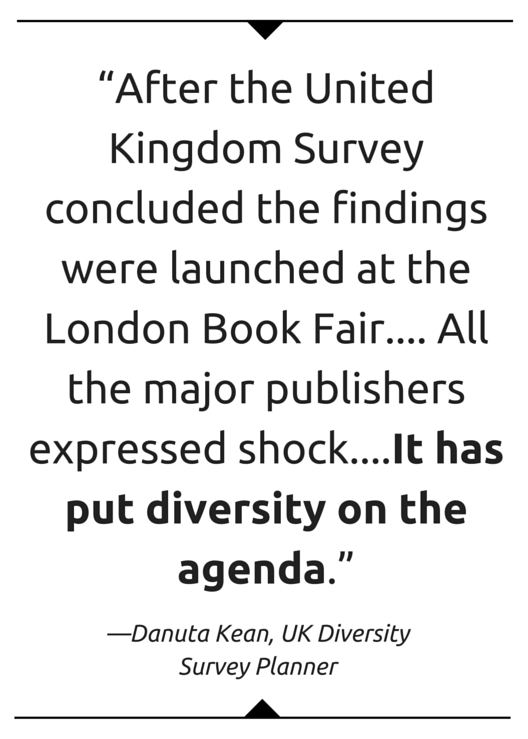 “After the United Kingdom Survey concluded the findings were launched at the London Book Fair with a major press conference that was attended by over 100 people,” Danuta said. “Coverage in the national and trade press was extensive. All the major publishers expressed shock, but feedback among BAME authors and staff was very good: the report was true to their experiences and there was relief that it was being addressed in a hard-hitting manner. It has put diversity on the agenda.
“After the United Kingdom Survey concluded the findings were launched at the London Book Fair with a major press conference that was attended by over 100 people,” Danuta said. “Coverage in the national and trade press was extensive. All the major publishers expressed shock, but feedback among BAME authors and staff was very good: the report was true to their experiences and there was relief that it was being addressed in a hard-hitting manner. It has put diversity on the agenda.
“Spread the Word [the organization which created the study] has now met with HarperCollins and Penguin Random House and is establishing schemes to improve the situation with them. HarperCollins is the best: John Athanasiou, its head of people, has been a driver for change and asked me to present to the main board. He has also established a company-wide diversity forum and had a conference for staff to address issues raised in the report. The diversity firm, Equip, ran a poorly attended workshop at which I spoke. The feedback and enthusiasm was good, but I question the drive to bring about lasting change.
“Goldsmiths University held a diversity in the media day at which I presented our findings. Discussions have been held at three literary festivals, on national and digital radio, and diversity hashtags have been promoted on Twitter—the latest is #diversitydecember. Spread the Word also hosted a training and awareness day for BAME people interested in publishing and writing. More initiatives and meetings are planned for next year, and we raising funding for follow-up research.”
While the time and the scope of the survey did not allow us to document all inclusion initiatives, we encourage publishers, reviewers, and others to add commentary to the comments section below. What is your company or organization doing to address this problem?
Read also: Behind the Scenes Of Publishing’s First Diversity Baseline Survey and Where Is the Diversity in Publishing? The 2015 Diversity Baseline Survey Results
For press inquiries or permission to reprint, please contact hehrlich[at]leeandlow[dot]com.
Since its release, the Diversity Baseline Survey (DBS) has become the most visited blog post we have ever produced. The DBS has been widely read and written about, and has opened up a renewed interest in how to improve staff diversity in the publishing industry. In our first piece, Behind the Scenes of Publishing’s First Diversity Baseline Survey, we covered the methodology and obstacles we faced conducting the survey. In this piece we will shed light on what happens next—and what’s already happening to improve the numbers.
We surveyed a handful of the publishers and reviewer journals that participated in the DBS and asked them what initiatives they are planning or already have in place to make diversity a priority in their organizations. Here are some of the responses we received back:
“When Jason Low asked me what our reviewers looked like in terms of their diversity, I had no idea. It was a question that had never been asked.” — Kiera Parrott, School Library Journal
Kiera Parrott, Reviews Director, School Library Journal and Library Journal: Participating in the survey was the first concrete and actionable thing I could do to be part of the solution. Even though I had a fair guess on the demographic makeup of our reviewers (most of them were recruited from ALSC committees, and that group is rather homogenous), I wanted actual numbers. My hope was that the statistics would help me pinpoint exactly where we needed to grow and develop.
The next steps after the survey have been 1) intentionally recruiting more diverse reviewers, and 2) developing diversity/cultural literacy training for our existing reviewers. Sometime in mid-2016, I’m launching a special course just for SLJ reviewers on diversity and cultural literacy. We anticipate this course beginning sometime in late Spring/early Summer.
Editorial note: Kiera also gives a much more detailed report on her progress diversifying her reviewer pool in an interview she gave at the Reading While White blog.
Jason Low, Publisher, Lee & Low Books: While many are aware of our 25-year mission to publish award-winning diverse books, we currently have several other initiatives in place.
To start, since the DBS was all about staff diversity, Lee & Low can firmly state that we practice what we preach. Lee & Low hires diversely and as a result our staff is very diverse. Overall 69% of our staff identifies as people of color (PoC). Departmentally the company breaks down like this: editorial: 50% PoC; marketing/publicity: 75% PoC; sales: 50% PoC; Operations: 100% PoC. We have fluent Spanish speakers in editorial, marketing/publicity, and sales.
Staff Diversity Training: Last year we sent a number of LEE & LOW staff members from different departments to an “Undoing Racism” workshop, held by the People’s Institute for Survival and Beyond. We decided to do this workshop because even with LEE & LOW’s focus on diverse books, we felt that our staff would benefit from specific training in anti-racism concepts.
Author Award Contests: We sponsor two author awards for unpublished writers of color. Our New Voices Award is in its 17th year. The New Voices Award has launched the careers of 14 authors of color (with the work of three more authors currently in development), and we have given honor awards to another 11 authors. In 2013, we launched the New Visions Award, an award for unpublished authors of color who write middle grade and young adult novels.
Diversity in Publishing Internship: To address the lack of opportunities for diverse staff in publishing, we converted our paid internship program to one that is for diverse candidates only. Our internship program is designed to give candidates the kind of publishing experience and exposure they would need to consider a career in publishing.
Lee & Low and Friends Scholarship: In partnership with the Center for the Study of Children’s Literature at Simmons College, we have established a scholarship to increase diversity at the graduate school level. The Lee & Low and Friends Scholarship provides opportunities for students of color to enroll in the most prestigious children’s literature graduate program in the United States.
Diversity Gap Series: We published a series of eight studies that include statistics and interviews illustrating that the lack of diverse representation is a society-wide problem. The subjects covered so far: The Tony Awards, The Emmy Awards, The Academy Awards, The children’s book industry, The New York Times Top 10 Bestseller List, US politics, Sci-Fi and Fantasy Films, and Silicon Valley.
Angus Killick, Vice President/Associate Publisher, Macmillan Children’s Publishing Group and Monique Patterson, Editorial Director, Romance and Executive Editor, St. Martin’s Press: Macmillan established a Diversity & Inclusion Council this year aimed at promoting a broader representation of differences—gender, race, ethnicity, religion, sexual orientation, physical ability, age, gender identity and expression, family status, economic background and status, geographical background, and perspective in the workforce and the books we produce. The Council steers Macmillan’s diversity and inclusion efforts, and 1) determines priorities for programs and activities aimed at enhancing diversity in our books and authors and in our recruitment and retention efforts; 2) oversees sub-committees established to focus on individual priorities; 3) measures the results of our initiatives; and 4) reports back to the larger organization.
We’ve formed a number of sub-committees and each is involved in projects. For example, the Outreach Committee is creating a Publishing Ambassador Kit, so any employee can visit a middle or high school and talk about careers in publishing—not just in editorial, but in marketing, production, finance, IT. The Recruiting and Retention committee worked with We Need Diverse Books to expand our Intern pool this past summer and has expanded recruiting efforts to schools outside the tri-state area. The Acquisition and Marketing Committee is developing strategies for editors and imprints to broaden submissions both from the one-on-one meetings of editors and agents and from outreach to organizations such as the Asian American Writers Workshop or historically black colleges and their writing programs. Also, our Council is looking into participating in events such as the Harlem Book Fair and the LGBTQ Graphic Novels event. We have also reached out to the AAP and Young to Publishing to find ways to expand on what already exists. Macmillan joined other publishers in September in a baseline survey on our workforce and added several questions of its own to measure awareness and attitudes about Diversity and Inclusion.
We are in the early stages of exploring what will increase and sustain diversity in our books, our readership, and our workforce. We have much to learn, but look forward to continuing our efforts.
Vicky Smith, Children’s & Teen Editor, Kirkus Reviews: I’m not sure you can call an intention an initiative, but we are working hard to describe race and ethnicity accurately when we see it in the books that we review, as well as sexual orientation, gender identity, and disability. We hope that by including that information in our reviews our readers will be able to make the most responsible purchasing decisions for their homes and libraries. I am also actively recruiting reviewers of diversity (for lack of a better term), who will provide a variety of lenses into the literature.
“Our commitment to fostering diversity is reflected in our day-to-day workplace conduct, as well as by how we continue to find, develop, and publish a wide range of authors from many different cultural backgrounds, across all genres, for diverse audiences of readers everywhere.” — Paige Mcinerney, Penguin Random House
Paige Mcinerney, Vice President Human Resources, Penguin Random House: Our commitment to fostering diversity is reflected in our day-to-day workplace conduct, as well as by how we continue to find, develop, and publish a wide range of authors from many different cultural backgrounds, across all genres, for diverse audiences of readers everywhere.
At Penguin Random House, we have a robust, paid Internship Program. In recruitment for this program, we actively work with several diversity partners with whom we have longstanding and productive relationships. These include, among others, The Posse Foundation, Prep for Prep, and beginning in 2016, the United Negro College Fund in partnership with the Association of American Publishers. We work with these groups on all internship recruitment and also commit to filling a percentage of our internship openings with qualified candidates from these organizations.
Some of our divisions have employee groups that meet regularly to discuss how to maximize the potential of our diversity-related books, and how to make sure that their division is working toward as much inclusiveness as possible.
This spring, Penguin Young Readers is sponsoring (in a partnership with We Need Diverse Books) a writing contest that will award a publishing contract to a previously unpublished author who self-identifies as a person of color or non-Caucasian.
Karen Lotz, President and Publisher, Candlewick Press: As an independent publisher, we’ve always understood that it’s our authors and illustrators who set us apart. Our roster of creators includes new and established talents from all backgrounds who themselves are committed to ensuring that ALL readers will be able to see themselves and the people they love reflected in the pages of—and on the covers of—the books they read. On the corporate level, from the covers of the Candlewick advertising catalog to our featured titles at conventions and shows, we consistently and consciously make choices to feature characters from many different backgrounds; we choose to illustrate characters of different backgrounds not just in the ‘issues’ books but across the board, to better depict society as a whole. We hope this creates an open and inviting atmosphere where authors and artists from diverse populations will feel welcome to publish. We understand, furthermore, that the economic support and financial offers we make to artists and authors and the quality we invest in producing each and every title are important to attract all authors and artists, certainly including those from diverse backgrounds.
And finally, we are very proud of the recognition our books have come to receive from outside groups, including recent NAACP Image and Honor Awards; Stonewall Awards and Honors; Pura Belpré Awards and Honors; and Coretta Scott King Awards and Honors. We are particularly grateful this year to the Coretta Scott King Committee for their bestowal of the John Steptoe New Talent Award to Ekua Holmes for Voice of Freedom: Fannie Lou Hamer, because at Candlewick we really work very hard to try to discover new talent and give brand-new creators of children’s books a graceful and rewarding entry into the world of children’s publishing.
This same commitment to creating a welcoming environment extends to our staffing. In recruiting, we make every effort to reach out to educational institutions and organizations whose goal is to cater to diverse populations. We have a special art resource coordinator on staff whose role is exclusively dedicated to seeking new talent from art schools and programs; she communicates wherever she goes that Candlewick welcomes artists from diverse backgrounds and with diverse interests. Throughout their careers, we support and encourage all of our staff to continue their participation in diversity studies, panels, and educational programs, including the CBC’s diversity program efforts and other local and national opportunities, including WNDB initiatives. We support our authors when they wish to do the same. We also work very closely with First Book and Jumpstart, as well as other literacy organizations whose goals include getting high-quality and appropriately representational books into the hands of all children—regardless of their families’ compositions, backgrounds, or economic situations.
“It seems clear that for those numbers to increase, there have to be diverse people working in publishing. And the first step towards making change is exposing the problem.” — Marina Tristán, Arte Público Press
Marina Tristán, Assistant Director, Arte Público Press: We obviously work to promote Latino books and authors, but we also try to promote books by other minority writers and publishers via our social media pages and in conversations with teachers and librarians.
In regard to hiring, we don’t honestly have any initiatives per se in place, but we do have a very diverse staff—mostly Latino/Hispanic—because we feel it’s important to employ a bilingual/bicultural staff.
Learning from the UK
There’s no way for us to predict how the United States publishing industry will tackle the diversity problem and how successful these initiatives will be. But looking at efforts similar to our own is a useful exercise. The DBS has precedence in a publishing diversity study conducted in the United Kingdom in 2014. The United Kingdom study had a scope larger than the DBS. In the UK they surveyed 66 publishing companies of all sizes, 49 literary agencies, and 536 authors. They spoke with authors, publishing professionals, and Human Resources heads. Earlier this year, we wrote about 6 key findings from that study. Recently we reached out to Danuta Kean, one of the planners of the survey, and asked her about the status of their research.
“After the United Kingdom Survey concluded the findings were launched at the London Book Fair with a major press conference that was attended by over 100 people,” Danuta said. “Coverage in the national and trade press was extensive. All the major publishers expressed shock, but feedback among BAME authors and staff was very good: the report was true to their experiences and there was relief that it was being addressed in a hard-hitting manner. It has put diversity on the agenda.
“Spread the Word [the organization which created the study] has now met with HarperCollins and Penguin Random House and is establishing schemes to improve the situation with them. HarperCollins is the best: John Athanasiou, its head of people, has been a driver for change and asked me to present to the main board. He has also established a company-wide diversity forum and had a conference for staff to address issues raised in the report. The diversity firm, Equip, ran a poorly attended workshop at which I spoke. The feedback and enthusiasm was good, but I question the drive to bring about lasting change.
“Goldsmiths University held a diversity in the media day at which I presented our findings. Discussions have been held at three literary festivals, on national and digital radio, and diversity hashtags have been promoted on Twitter—the latest is #diversitydecember. Spread the Word also hosted a training and awareness day for BAME people interested in publishing and writing. More initiatives and meetings are planned for next year, and we raising funding for follow-up research.”
While the time and the scope of the survey did not allow us to document all inclusion initiatives, we encourage publishers, reviewers, and others to add commentary to the comments section below. What is your company or organization doing to address this problem?
Read also: Behind the Scenes Of Publishing’s First Diversity Baseline Survey and Where Is the Diversity in Publishing? The 2015 Diversity Baseline Survey Results








